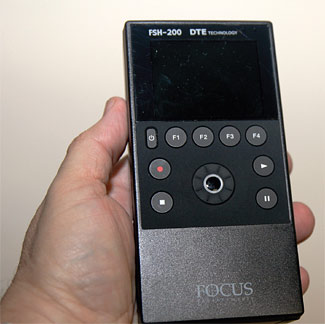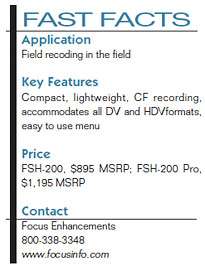Focus Enhancements FSH-200, FSH-200 Pro

The Focus Enhancements FSH-200
The workflow of today centers on tapeless acquisition. Yet we must remember that it was Focus Enhancements—through its FireStore Direct to Edit products— that led the way to tapeless acquisition when everyone was exclusively shooting tape.
Life was simpler in those good old days of just a few years ago. We shot SD, and then HDV came along in a few flavors. Focus was already producing hard drive-based recorders for SD, and quickly entered the HDV market with offerings for Sony, JVC and Canon camera products. Working with Panasonic, Focus developed the FS-100 for DVCPRO HD cameras, extending recording time beyond what was available on P2 storage cards.
All of these earlier units, as well as the more recently introduced FireStore FS-5, were hard drive-based. While reports of drive failures have been infrequent (owing to the ruggedized mechanisms and excellent shock-absorbing features of the units), such mechanical devices with their associated potential for failure made some shooters nervous.
FEATURES
Focus has now answered those concerns with the introduction of its FSH-200 and FSH-200 Pro direct-to-edit solid-state recorders. Based on the same compact, lightweight form factor as the FS-5, the FSH-200 and FSH-200 Pro record to 16 GB or 32 GB CF cards (SanDisk-supported, primarily), storing as much as 2.3 hours of video per card. You just insert a CF card into a side slot, connect the FireWire cable to your HDV camcorder and then record. It's that simple. It's also very important to note that the one unit supports all the flavors of HDV offered by Sony, Canon and JVC.
The 200s will record in any format for any NLE, including QuickTime, AVI and M2T. Files can be brought directly into your timeline without any conversion or log and transfer time. HDV shooters can really have the best of all possible worlds. Run tape and just archive it. Copy files from the CF card to your editing system and then reformat the CF card. Tape still remains an inexpensive and durable medium for archiving.
IN USE
I recently had the opportunity to work with the FS-200 and immediately noticed how light and compact it is compared to the much heavier and bulkier FS-100 unit that I once owned. Focus provides a mount for just about any HDV camera. The display screen is clear and shows all control options clearly—it should be remembered that the FS-200 is not a playback device and does not display video, only status. What was also tremendously impressive was its auto-sensing of the input video source—720 or 1080—running at any possible frame rate.

(The display shortcomings of the FS-200 have been rectified with the FS-200 Pro, which costs only $300 more. FS-200 owners may return their device to Focus for a paid firmware upgrade to the Pro level.)
The Pro adds proxy thumbnail display, clip naming, creation and sharing of MPEG- 4 proxies, either through the card or through optional wired or wireless network adapters. This opens any number of possibilities for Web sharing of video. You record and create MPEG-4 proxies. Then just upload via the optional network interfaces. Most impressive, though, is that clip-naming feature. Using a computer or handheld device, all kinds of metadata can be assigned to a clip, and that metadata remains with the clip upon ingest to whatever NLE solution you use.
SUMMARY
For anyone working with HDV, either the FSH-200 or FSH-200 PRO represents a major upgrade to the workflow. The tedious task of logging HDV tape is now gone, and the time saved more than makes up for the reasonable cost of these units.
Unfortunately, however, the FSH devices are applicable only to a specific segment of a market that is being flooded with new cameras featuring higher-quality codecs. Virtually all of the newer camcorders shoot to one form or another of solid-state media, eliminating the need for a solid-state external device that does not provide any enhanced quality of video (unlike much more expensive units that can record from HDMI or SDI outputs to data rates and color samplings greater than the native camera).
In short, the FSH units are wonderful devices for a format that is being superseded, but an FSH-200 or FSH-200 Pro really should be part of any HDV shooter's kit.
Ned Soltz is an author, editor, educator, consultant, and contributing editor to both DV and Videography magazines.
The professional video industry's #1 source for news, trends and product and tech information. Sign up below.
